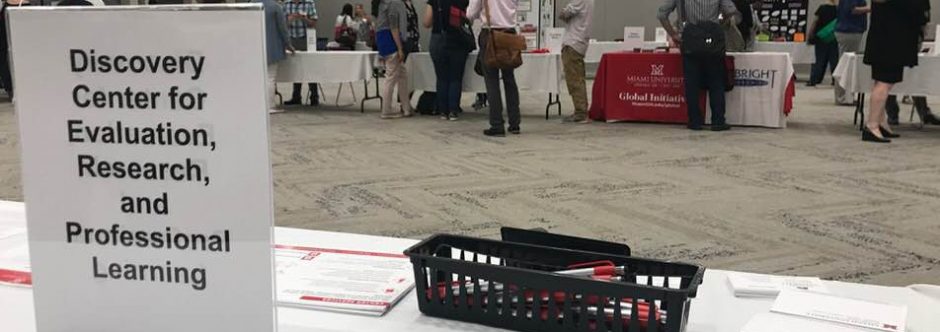Advice in Building and Boasting a Successful Grant Funding Track Record
By: Emily Ryan
In late January (2016), a panel of five experts from Miami University (Oxford, OH), including faculty and staff from departments and offices across campus, met to share their knowledge and experiences pursuing and securing a variety of funding types, for a range of initiatives. Panel participants included Dr. Sarah Woodruff (Director, Discovery Center for Evaluation, Research, and Professional Learning), Dr. Amity N. Noltemeyer (Associate Professor, Educational Psychology), Dr. Nazan Bautista (Associate Professor, Science Education), Dr. Paul Flaspohler (Associate Professor, Clinical Psychology), and Mr. Whitney Riley (Director, Corporate and Foundation Relations). As someone interested in using my skills to support the research and/or non-profit efforts of others, I naturally attended the panel discussion. During the event, I wrote down several quotes from the panelists, which struck me as valuable yet raw tidbits of advice about navigating (and surviving) the grant proposal seeking process. Since the panel discussion, two particular pieces of advice have stayed with me, mostly because they made me reconsider what it means and what it takes to build and boast a successful grant funding track record.
Grant Seeking Advice – Part 1: Develop Relationships
First, the panelists noted the importance of developing partnerships when seeking funding—amongst colleagues, whether within academia, within your surrounding community, or just within the non-profit world, in general. More specifically, the panelists discussed the importance of developing partnerships “where the action is taking place.” They emphasized the value of getting to know others, particularly, those in fields, institutions, or within the community, whose goals, interests, and agendas mirror your own. “Others” could include researchers, professionals, local groups/organizations within a person’s own field of study, or even funding agencies/entities, state and federal representatives, or policy makers whose initiatives and agendas are aligned with your own research, project, or program goals. In sharing their own experiences, panelists suggested that there can be great benefit to building these types of relationships with others. Teaming up with like-minded people, with similar interests can allow for knowledge sharing, sharing of successes/failures, or even full-fledged future collaboration. In relation to the planning/design phase of a research study or project/program initiative, the benefits of developing partnerships are two-fold: 1) Partnerships can allow you to divide and conquer tasks, in order to complete work (e.g., performing literature reviews; writing and editing the proposal; tackling tedious grant submission requirements); and 2) With the right mix of people, partnerships can serve to greatly strengthen the credibility and sustainability of the work being proposed for funding. In a nutshell, the more people you get to know (i.e., the more relationships, collaborations, and partnerships you form), the more robust your “wheelhouse” of knowledge and experiences becomes; which can both decrease your individual workload, and increase your chances of getting funded.
Grant Seeking Advice – Part 2: Do Not Fear Rejection
The second piece of advice, or rather, confession shared by panelists was that the grant writing process is a “human experience.” No matter who you are, or what your work involves, the grant proposal writing and submission process includes a lot of moving parts that need to come together, in the right order, at just the right time. If you’re wondering where the “human” part factors into the equation, well, in my 10+ years of experience with this type of work, I’ve learned that the process for acquiring external funding isn’t for the faint of heart. A lot of hard work goes into pulling together a successful grant proposal (large or small). For almost any grant submission, applicants are expected to communicate their ideas in a detailed, persuasive, yet concise manner, all while following strict submission limitations and guidelines, by a strict deadline. This demanding process involves, late nights, a relentless review and revision process, and a do-what-it-takes–to-meet-the-deadline mentality. If this part of the grant writing process doesn’t seem human enough to you, then think for a moment, about what an applicant and his/her team might feel, when after all of their hard work, their grant proposal/project gets rejected for funding. Being turned down by a funding agency can be a hard pill to swallow, and this part of the grant writing process often triggers a feeling of rejection, which in any case, is a very human experience. As an example, and to put things into perspective, further, the success rate for competitive proposals awarded in FY15 under the National Science Foundation’s, Education and Human Resources (EHR) Directorate was only 20% (NSF, August 2015). In sum, unless you are a one-man or one-woman power house (a.k.a., an incredibly intelligent miracle worker with unlimited amounts of energy, time, drive, fine-tuned persuasive writing/editing skills, and the ability to synthesize complex information from a variety of sources, in a variety of ways, within a nearly impossible number of pages) then the process of securing external grant funding requires you to collaborate with others. It requires time. It requires dedication. It requires a team of thick-skinned folks who are willing to work toward a common goal, for as long as it takes to acquire necessary funding, and all of whom can deal with rejection, to some extent.
To circle back around, not one of the persons sitting on the panel at Miami this January achieved his/her grant funding success alone. It takes a plethora (a “wheelhouse,” if you will) of knowledge and experience (along with a small army) to build a successful grant funding track record. And if you glean anything from this article, or the advice I’ve shared from Miami’s recent panel discussion, just remember these few things—whether you’re just starting to build partnerships and relationships, whether you’re submitting a grant proposal for the first time or the tenth time, whether you’re feeling the sting of rejection, or whether you’re boasting your grant funding track record online—we’re all in this together, and someone, somewhere along the line, has likely supported you in your quest for funding! In this line of work, “success statistics” cannot technically be claimed by one individual—so, please also remember to give credit where credit is due, because. . .
- Building a successful grant funding track record requires teamwork, collaboration, and partnerships. *You can increase your odds of a positive outcome by surrounding yourself with like-minded, dedicated, hard-working people.
- The grant writing process is a very human experience. *Successfully securing grant funding requires you to develop a thick skin—you cannot fear rejection, it’s merely a part of the process. And for those currently navigating the aftermath of “rejection,” consider one additional, positive nudge forward from one of the Miami panelists: “Rejection is just the next step toward getting your foot in the door…toward getting awarded [funded].” *You, essentially, increase your odds of getting funded, with each new submission.

